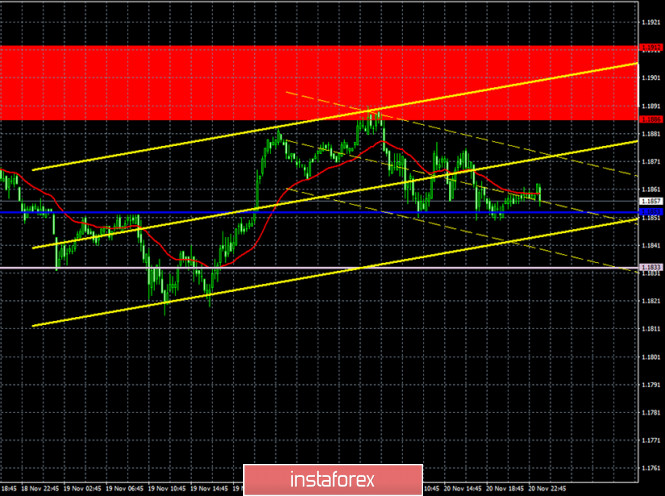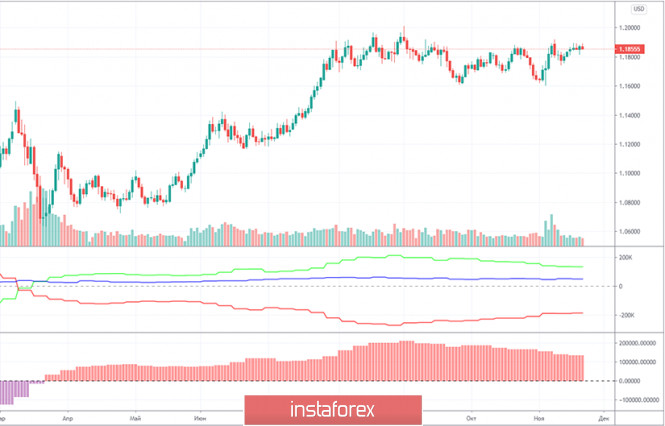EUR/USD 1H
The EUR/USD pair continued its horizontal movement on the hourly timeframe on November 20, which was observed in the last few days. Clearly moving sideways under the resistance area of 1.1886-1.1912. Take note that the entirety of last week was extremely boring despite the fact that there was news, and that there were also quite important reports and events. Nevertheless, market participants took a week off and practically did not trade. Volatility was no more than 50 points every day. Well, the technical picture has practically not changed during this time. The price tried not to overcome the 1.1886-1.1912 area three times, trying to gain a foothold within it, but all three attempts ended in failure. Therefore, the pair did not move up, and it did not fall either, and it was just not possible to get out of the 1.1700-1.1900 horizontal channel, in which the quotes have been in for three months. Traders can only wait in this situation. Wait for news, events, an increase in market activity, and just wait until the end of the, intra-week flat.
EUR/USD 15M

The lower linear regression channel turned to the downside on the 15-minute timeframe. However, the key role for the EUR/USD pair is now played by the 1.1886-1.1912 area, which buyers cannot overcome in any way. The euro's future prospects depend on overcoming it or not overcoming it.
COT report

The EUR/USD pair increased by 40 points in the last reporting week (November 10-16). As you can see, price changes are still minimal. There were certain bursts of activity during the US presidential elections, but they ended very quickly and now the pair is just trading in a horizontal channel, with minimal volatility. Therefore, we expect clarification of the current situation from the Commitment of Traders (COT) reports. Unfortunately, COT reports for the last 8-10 weeks now show that non-commercial traders are reducing their net position. This means that their sentiment is becoming more bearish. The green and red lines of the first indicator show the net positions of commercial and non-commercial traders, and when they are far from each other, this is considered a strong signal for a trend change. However, the lines have moved away and they have been moving towards each other for two months now. There is no downward trend. The "non-commercial" group of traders, which is the most important and significant, opened 2,000 Buy-contracts (longs) and 1,500 Sell-contracts (shorts) for the euro during the reporting week. Therefore, there is simply no change in the mood of this group of traders. We are much less interested in other groups of traders. In general, we have a somewhat paradoxical situation, as professional traders have been reducing the number of purchases of the euro currency and increasing sales for more than two months, but the euro does not fall. Nevertheless, based on the data of the report, we still believe that the peak of the entire upward trend was near the 1.2000 level and sooner or later the downward movement will start.
No macroeconomic reports from the European Union and the United States last Friday. The markets are frankly tired of all the political circus in America thanks to Donald Trump, and traders are no longer interested in the coronavirus pandemic as they were back in the spring. However, take note that the markets are not paying too much attention to macroeconomic statistics at this time. In general, we can say that the general fundamental background has the greatest influence now. However, it consists of such a large number of factors and topics (at this time) that it is impossible to interpret and characterize it unambiguously. Moreover, in the long term, the pair has been flat for three months, in the medium term - for a week. What kind of influence can we talk about at all? Naturally, European Central Bank President Christine Lagarde's speech from last Friday did not change anything either.
The European Union and the United States will publish business activity indices in the services and manufacturing sectors on Monday, November 23. As well as composite indices. Analysts expect business activity in the EU service sector to seriously deteriorate, which is not at all surprising given the lockdown introduced in many European countries. On the other hand, there is no strict nationwide quarantine in the United States, so the service sector should be fine. Therefore, in theory, the US dollar may have an advantage on Monday, but only minimal, since traders are now paying little attention to macroeconomic statistics in general, and business activity indices are far from the most important statistics.
We have two trading ideas for November 23:
1) Buyers continue to keep the pair above the Kijun-sen line (1.1853), but are not yet able to overcome the resistance area of 1.1886-1.1912. Therefore, you are advised to open long positions while aiming for the resistance level of 1.2007 if this area is overcome by the bulls. Take Profit in this case will be up to 70 points.
2) Bears are still in the shadow of bulls. Thus, to be able to open sell orders while aiming for the support level of 1.1747, the price must settle below the Kijun-sen (1.1853) and Senkou Span B (1.1833) lines. Take Profit in this case can be up to 70 points.
Forecast and trading signals for GBP/USD
Explanations for illustrations:
Support and Resistance Levels are the levels that serve as targets when buying or selling the pair. You can place Take Profit near these levels.
Kijun-sen and Senkou Span B lines are lines of the Ichimoku indicator transferred to the hourly timeframe from the 4-hour one.
Support and resistance areas are areas from which the price has repeatedly rebounded off.
Yellow lines are trend lines, trend channels and any other technical patterns.
Indicator 1 on the COT charts is the size of the net position of each category of traders.
Indicator 2 on the COT charts is the size of the net position for the "non-commercial" group.
The material has been provided by InstaForex Company - www.instaforex.com